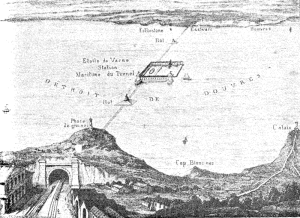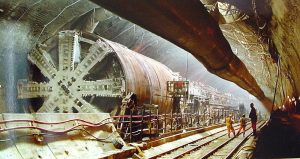Introduction:
The Channel Tunnel, often referred to as the “Chunnel,” stands as a testament to human ingenuity and determination. This remarkable feat of engineering spans the English Channel, connecting the United Kingdom and France, two nations with a history intertwined yet separated by the waters of the Channel. In this article, we will explore the fascinating story behind the conception, planning, and construction of the Channel Tunnel, highlighting the challenges faced and the ground breaking solutions that brought this ambitious project to life.
Historical Context:

The idea of creating a fixed link between England and France dates back centuries, with various proposals and plans presented over the years. However, it wasn’t until the latter half of the 20th century that serious discussions began to take shape. The increased need for efficient transportation and communication between the two nations, coupled with advancements in engineering and technology, laid the groundwork for the Channel Tunnel project.
Conception and Planning:
The first serious proposal for a Channel Tunnel came in the early 19th century, but it faced numerous challenges and skepticism. It wasn’t until the late 20th century that the idea gained traction. In 1981, the Channel Tunnel Group/France-Manche (CTG/F-M) and Eurotunnel, two groups formed by private companies on both sides of the Channel, submitted proposals for the construction of the tunnel.
The plan involved building three tunnels – two for trains and one service tunnel. This ambitious design aimed to accommodate both passenger and freight traffic, fostering economic and social ties between the UK and France. The British and French governments endorsed the project, and in 1986, the Treaty of Canterbury was signed, officially launching the construction of the Channel Tunnel.
Engineering Marvel:
The Channel Tunnel project presented an array of engineering challenges, primarily due to the underwater passage beneath the English Channel. The tunnel had to withstand the harsh marine environment, accommodate high-speed trains, and ensure safety for passengers and cargo.
Tunnel Design:
Engineers opted for a combination of tunneling methods to overcome the geological challenges posed by the diverse terrain beneath the Channel. The tunnel consists of three interconnected tubes – two main rail tunnels and a smaller service tunnel. Each main tunnel measures 7.6 meters in diameter, providing ample space for trains and ventilation.
The tunnel’s alignment was crucial, considering the variations in geology beneath the Channel. Engineers conducted extensive geological surveys to understand the composition of the seabed and plan the tunnel route accordingly. The alignment was designed to minimize potential risks such as soft ground, fault lines, and challenging rock formations.
Tunnel Boring Machines (TBMs):
To excavate the tunnels, engineers employed state-of-the-art Tunnel Boring Machines (TBMs). These massive machines, resembling cylindrical submarines, played a pivotal role in the construction process. Equipped with rotating cutting heads, TBMs could bore through various geological formations efficiently.
As the TBMs advanced, they simultaneously installed precast concrete tunnel segments to form the tunnel lining. This method ensured the stability and integrity of the tunnel structure. The TBMs operated around the clock, carving their way through the earth beneath the Channel.
Safety Measures:
Safety was a paramount concern throughout the construction process. Engineers implemented rigorous safety protocols, including the installation of emergency evacuation passages and a comprehensive fire detection and suppression system. The service tunnel, located between the two main rail tunnels, served as an emergency escape route and facilitated maintenance and rescue operations.
Construction Challenges:
Constructing the Channel Tunnel presented a series of formidable challenges. One of the primary obstacles was the presence of varying geology beneath the Channel, ranging from chalky terrain to more solid rock formations. Engineers had to adapt their tunneling methods to accommodate these differences, requiring a high level of precision and flexibility in the construction process.
Financial and Political Hurdles:
The Channel Tunnel project faced significant financial and political hurdles. The initial estimated cost of the project soared, leading to financial difficulties for the companies involved. Political debates and concerns over safety and security also added to the complexity of the project.
In 1990, Eurotunnel faced a financial crisis, leading to a restructuring of the project’s financing. The cost overruns and delays strained relations between the UK and French governments. However, despite these challenges, construction continued, and the engineering teams persevered in their mission to connect the two nations beneath the English Channel.
Success and Inauguration:
After years of perseverance and overcoming numerous challenges, the Channel Tunnel was officially completed in 1994. Queen Elizabeth II and President François Mitterrand inaugurated the tunnel in a historic ceremony. The Eurostar passenger service commenced operations shortly afterward, offering a high-speed rail link between London, Paris, and Brussels.
Impact on Transportation and Economy:
The completion of the Channel Tunnel revolutionized transportation between the UK and France. The Eurostar service provided a swift and efficient mode of travel, reducing journey times between London and Paris to just over two hours. The tunnel also facilitated the transportation of goods, fostering economic ties between the two nations.
The economic impact extended beyond the immediate region, with the Channel Tunnel serving as a vital link for trade between the UK and continental Europe. It provided a reliable and expedited route for freight transportation, contributing to the growth of cross-border commerce.
Conclusion:
The Channel Tunnel stands as a testament to human perseverance and engineering excellence. The successful realization of this ambitious project not only connected two nations but also transformed the way people and goods move between the UK and France. As a symbol of international collaboration and innovation, the Channel Tunnel remains a remarkable achievement in the history of modern engineering, leaving an indelible mark on the landscape of cross-border transportation.





